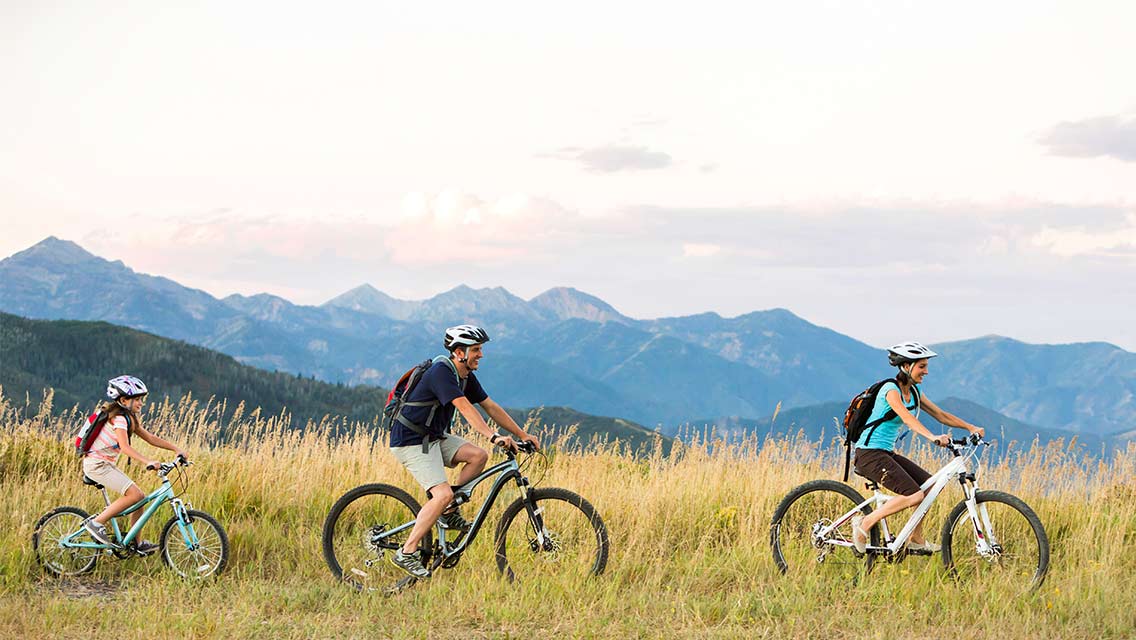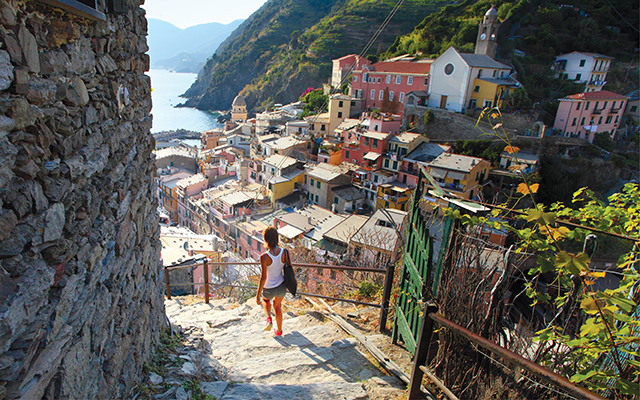I grew up at the tail end of the golden age of the American road trip. Like many kids raised between the end of World War II and the 1970s recession, I saw much of the country from the back-facing rear seat of my family’s wood-paneled station wagon.
Every summer we set out from Minnesota, traveling freeways, highways, and back roads to destinations as varied as the Florida Keys, Disneyland, and Maryland’s Assateague Island. We camped in state and national parks along the way and returned home within a week or two.
We loved being able to see so much of this beautiful country. But the more miles we covered each day, the more bored, antsy, and irritable we all became.
The trick to making road trips magical, I learned, is getting out of the car as much as possible.
Whether you spend a few months or a few days traveling along these four routes, meaningful adventure is right outside your car door.
The U.S. Civil Rights Trail
Honor American History
Highlighting more than 100 historic sites, primarily in southern states, the U.S. Civil Rights Trail was formally established in 2018. It includes museums, churches, courthouses, schools, and other places where activists challenged segregation and fought for equal rights during the 1950s and ’60s.
Teachers Mark and Leslie Swiggum didn’t have the benefit of such a comprehensive map 17 years ago, when they took their four kids on a road trip to learn more about the civil-rights movement.
Instead, the family visited significant sites they’d read about: Birmingham, Montgomery, and Selma, Ala.; Greenwood and Clarksdale, Miss.; and Memphis, Tenn. Wherever they stopped, at museums and restaurants and on city streets, they started conversations.
They were lucky enough to meet several “foot soldiers” — primarily African-American activists — who shared their own stories. Joanne Bland, director of Selma’s Voting Rights Museum, told them about marching on Bloody Sunday as an 11-year-old.
“After four days we realized how little we knew,” says Mark Swiggum, now 68 and retired. Swiggum, who is white, felt it was important to learn more, so when he and his family returned home to Eden Prairie, Minn., he immersed himself in the history of civil rights in this country. Then — out of passion, not as a business — he started leading tours of civil-rights landmarks throughout the South for church groups, book clubs, and retired businesspeople.
So when Kristi Rudelius-Palmer, a human-rights education and training consultant and former colleague of Swiggum’s daughter, planned a solo four-day civil rights trek — packed with stops at historic sites — she sought Swiggum’s advice.
In Jackson, Miss., she used the Jackson Civil Rights Movement Driving Tour brochure as a map for setting out on foot. She visited the home of Medgar Evers, his statue, and the library named after him. She talked with librarians who were old enough to remember the martyred activist.
In Selma, Ala., she visited museums and walked across the Edmund Pettus Bridge.
In Montgomery she talked with people at the Dexter Avenue King Memorial Baptist Church who remembered hearing the Reverend Martin Luther King Jr. preach his message of hope, and she toured the Civil Rights Memorial and Rosa Parks Museum.
It was an emotionally moving journey. “To understand the United States,” says Rudelius-Palmer, “we have to understand both the things we celebrate and the struggles and movements in which people have worked hard to create change.”
United States Civil Rights Trail: Plan a trip by state or by site, from the Supreme Court of the United States and the Mississippi Civil Rights Museum to roadside memorials. (Free resource.)
Jackson Civil Rights Movement Driving Tour: A city-specific driving tour with 81 sites. (Free.)
National Civil Rights Museum at the Lorraine Motel: At the site of Dr. Martin Luther King Jr.’s assassination in Memphis, Tenn., this is the country’s most visited civil rights museum. ($16 adults/$13 children ages 5 to 17.)
Selma to Montgomery National Historic Trail: Follow the same path civil rights activists marched in 1965 for the right to vote in central Alabama. In Selma, walk across the Edmund Pettus Bridge, the site of Bloody Sunday. Learn about the history of the marches and early voting by visiting the Lowndes and Selma Interpretive Centers. (Free.)
Blue Ridge Parkway
Camp, Hike, and Explore Small Towns
Stretching 469 miles through Virginia and North Carolina, the Blue Ridge Parkway is known as America’s Favorite Drive. Operated by the National Park Service, the road winds its way along the ridges and valleys of the Blue Ridge Mountains.
“It’s stunningly beautiful. Sometimes you drive and everything is a tunnel of trees, and then you come to these long views that go on forever,” says George Zahn, 60, a high school band and music teacher who grew up 30 miles from the parkway in Charlottesville, Va. “What’s most special about the road isn’t the road. It’s the location.”
There’s much to see and do: Visit the Cherokee Voices Festival in Cherokee, N.C.; explore Bristol Caverns; check out the Birthplace of Country Music Museum or the Biltmore Estate; or simply enjoy the natural surroundings.
As a child, Zahn loved family picnics along the parkway and hiking the short but strenuous trail to Humpback Rocks, which offers amazing views of the Shenandoah Valley. As a teenager, he hiked many miles of the Appalachian Trail, which runs near the parkway. After college he biked the parkway and slept in a hammock near a trail. The last time he visited, he stopped at wineries with friends.
Zahn recommends that visitors get out of the car and off the main road. Go camping or biking. Hike a trail. “Explore a county road heading east or west off the parkway and have lunch in a small-town café.” Stop at Rockfish Gap, a gateway to the parkway, for fruit. Peaches are in season from July to mid-August and apples from August to October.
Blue Ridge Parkway: With maps, a robust list of events, and suggested itineraries for foodies, motorcycle riders, and day trippers, this site will help you plan your perfect trip.
Appalachian Trail: This hiking trail, which runs from Maine to Georgia, is accessible from the Blue Ridge Parkway. Take a day hike, or hike and camp as long as you like.
Biltmore Estate: With a 250-room chateau and gardens designed by Frederick Law Olmsted, this estate in Asheville, N.C., is an American icon. (Daytime admission varies by season: $60 adult; free for kids 16 and under in summer.)
Birthplace of Country Music Museum: An affiliate of the Smithsonian Institute, this museum shares the story of Bristol, Tenn., and Bristol, Va.’s role in the birth of country music.
Great Divide Mountain Bike Route
Bike-Pack the Rockies
Bikes work great for road tripping, too, especially when you’re “bike-packing” — carrying only the bare minimum of gear and resupplying food along the way.
Spanning nearly 3,100 miles from Canada’s Jasper National Park to the Mexican border, the epic Great Divide Mountain Bike Route (GDMBR) traces the spine of the greater Rocky Mountains range, primarily using roads that run through public lands.
“There are dramatic mountain landscapes the entire way,” says Nathan Taylor, a cartographer for the Adventure Cycling Association (ACA), a 45-year-old nonprofit that has mapped 48,000 miles of cycling routes in North America, including the GDMBR. “The grandeur is amazing.”
Being immersed in wilderness was part of the reason Denver-based filmmaker Mike Dion entered the annual Tour Divide race. He made it as far as Wyoming before calling it quits, but he documented his efforts in the film Ride the Divide.
Not everyone tries to cover the whole trail in three weeks like the racers do. Some take on one section at a time over the course of years. Others sign up for a tour with or without gear support.
Kyle Trebotich, the ACA’s director of tours, says the GDMBR tends to attract the “more intrepid folks,” people who are interested in solitude and independence.
The training required to manage this challenging trail is worth it, says Dion. “It’s breathtakingly beautiful. And when you’re experiencing it at 8 to 10 miles per hour, you have time and opportunity to soak in the beauty and the sounds.”
If bike-packing seems intimidating, just start experimenting close to home. Each spring, cyclists around the world register for Bike Travel Weekend and try one- or two-night biking adventures.
“There’s no right or wrong way to do it,” says Dion. “Just make sure you go off and do an adventure. Don’t let fear hang you up.”
Adventure Cycling Association: This 45-year-old nonprofit can help you learn about adventure cycling and discover routes across North America. They sell maps and offer tours, including “family fun” tours in Idaho and the Erie Canal, with different levels of support. (Tours are $669 and up.)
Bike Travel Weekend: Want to learn more about bike travel? Take a trip in your own neighborhood. Each spring, cyclists around the world register for Bike Travel Weekend and try one- or two-night biking adventures.
Bikepacking.com: This site offers planning insight, routes, gear reviews, events, and adventure stories from and for biking’s minimalist-adventure crowd.
Dinosaur Diamond Scenic and Historic Byway
Learn About Fossils in Colorado and Utah
The Dinosaur Diamond Scenic and Historic Byway is a 512-mile loop that passes near Moab, Helper, and Vernal in eastern Utah, and Grand Junction in western Colorado. It’s a land of wind, water, and time that shaped mesas, rock outcroppings, and arches, and of forests and fertile agricultural pockets — and dinosaurs.
Craig Campbell and his wife, Mariah, of Kaysville, Utah, have taken their three kids several times to Dinosaur National Monument, where visitors step way, way back in time. Inside the Quarry Exhibit Hall, you’ll see more than 1,500 dinosaur fossils embedded in one stone wall.
They’ve also enjoyed visiting the Utah Field House of Natural History in Vernal; watching the stars, planets, and a comet through a telescope at Goblin Valley State Park, where there’s no light pollution; and exploring the rock dwellings and petroglyphs of Nine Mile Canyon, which has been called the “world’s longest art gallery.”
Craig and Mariah believe it’s important to share Native history with their children. “We’re visitors to this country. We weren’t here first,” says Craig, 39. “With the kids, we’re trying to instill that we’re part of something bigger, and that we have so much impact on the future based on how we live here now.”
The natural beauty of the Dinosaur Diamond Scenic and Historic Byway region has called me to visit more times than I can count. I’ve hiked at Arches and Canyonlands National Parks near Moab; rafted the Colorado River’s Westwater Canyon; visited the orchards and wineries of Grand Junction and Palisade; and spent a weekend at the AppleFest in Cedaredge near Delta, Colo.
Next time, I plan to visit Bears Ears National Monument, which has more cultural sites than any other national park or monument. I’ll start at the Bears Ears Education Center in Bluff, Utah, to learn how to visit this area — sacred to many Native American tribes — with respect. (For more on Bears Ears National Monument, visit “Why Bears Ears National Monument Matters”.)
Dinosaur National Monument: Visit one of the most impressive Jurassic Period dinosaur quarries in the world, where hiking trails lead to fossils and petroglyphs.
Bike Colorado Wine Country: Explore Grand Junction’s wineries and orchards by bike (or by kayak, canoe, raft, or car). It’s beautiful to visit in spring when fruit trees are in bloom, or August and September during harvest.
Canyonlands National Park: Enjoy backpacking, biking, boating, climbing, hiking, or horseback riding in this national park near Moab, Utah.
This originally appeared as “Head Off of the Highway” in the October 2019 print issue of Experience Life.





This Post Has 0 Comments